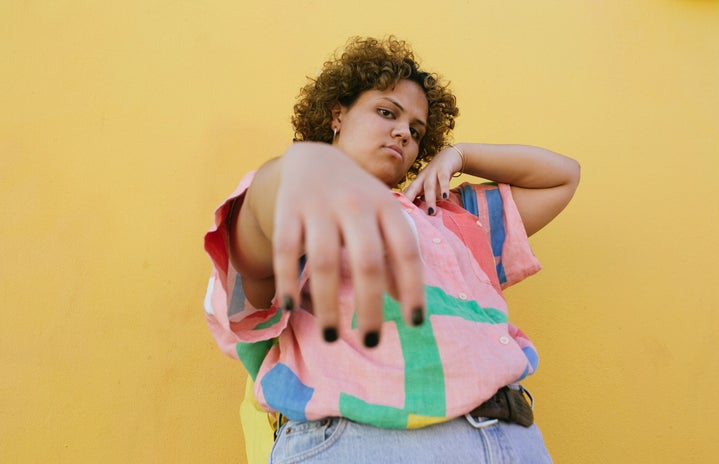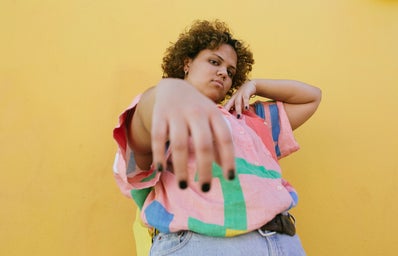If you have been on TikTok at all in the past few weeks you will have seen calls to “normalize” queer asethetics While on the surface it seems to praising queer aesthetics, it is much more harmful than you may think.
The largest problem with this trend is the wording; “normalize” queer aesthetics implies that before, when only queer people were using them, they were abnormal, and that straight people are required to make these expressions of queer identity normal. Being a queer individual myself, it pains me to see straight celebrities and creators being praised for embracing gender fluidity when queer people are still being killed and verbally abused for it.This applies especially to the Black queer community, who are targeted in unproportionate amounts. It also becomes a problem when straight celebrities are being praised more for embracing gender fluid looks than queer celebrities who have been doing it for much longer, possibly their whole lives. The most recent circumstance was when Harry Styles wore a dress for his Vogue photoshoot. This is nothing against Harry, he is a fantastic artist and I really respect him, his work, and his expression of himself through what he wears. However, when this photoshoot came out the Internet exploded, and it almost seemed like people thought that Harry Styles wearing a dress on something so well known as Vogue was a brand new concept. Just recently, in 2019, Billy Porter wore a dress tuxedo on the red carpet for the Oscars, and while he made multiple best-dressed lists, he did not receive nearly as much praise as Harry did. The difference? Porter is Black and gay while Styles is white and assumed to be straight. There are many more examples of queer people gender-bending fashion long before people like Harry Styles and Conan Grey did. David Bowie, Freddie Mercury, Elton John, Billy Porter, and Johnathan van Ness, as well as women like Marlene Dietrich and Gladys Bently, all challenged gender norms and gendered fashion and got little attention for it. Drag queens and kings have existed for decades, challenging gender through art and performance and getting attacked for it. The aesthetics of modern drag have been around for decades, and the history of gender expression goes back centuries. I’m not saying you have to be queer to dress in a gender fluid fashion. These fashion styles created by queer people allowed them to express themselves in a way that they were not able to in their regular lives and help them find a community with people who are like them. They used fashion to create a culture.
Queer fashion has a rich history that social media doesn’t understand. Fashion has been a huge identifier for fellow LGBTQ+ people, moreso since the distinction that was made between heterosexuality and homosexuality around the late 1700s. Around this time, being in a same-sex relationship or “cross-dressing” were both considered illegal, but they didn’t just go away. In order to find a community within an oppressive society, gay folks turned to fashion. In the 1800s macaroni and dandyism became a popular fashion among certain people. This type of fashion was widely called “effeminate” and people who dressed this way were believed to be gay. It’s unclear whether this fashion was actually popular within the gay community, but many people who study fashion consider it to be. Throughout the 1800s, fashion evolved, especially within the queer community, rewriting certain objects as symbols of queerness. In 1892, a few years before his trial for gross indecency (basically for being gay), Oscar Wilde asked his friends to wear a green carnation to the opening of his play Lady Windermere’s Fan, and it soon became a symbol of men who love men.
As society evolved, so did queer fashion. During the Roaring 20s, Drag Balls were created as a way to create a community among queer people in America. An underground hangout where you could dress and act the way you wanted, a break from hiding who you were. Drag as we know it today evolved from these balls. Of course, with the Great Depression came the end of Drag Balls. It was around this time that the “3-article” clothing rule was created, allowing police to arrest anyone who was not wearing at least 3 items of clothing belonging to their assigned gender. Popularized In the 1950s was lesbians wearing suits and very masculine clothing. While people like Anne Lister had tried this before in the early 1800s, it didn’t catch on until the 50s, influenced by Marlene Dietrich, who was a huge star at the time.Through the 1950s and onward, certain colours became symbolic of queerness. Green became a symbol of being gay, most likely the returning of the green carnation popular in the 1890s. The most famous colour used for expression of sexuality was lavender. Lavender is associated with two events, the Lavender Scare and the Lavender Menace (these were feminist groups trying to distance themselves from lesbians so as not to be given a bad rap). The Lavender Scare happened during the 1950s, at the onset of the Cold War, and was a side effect of the Red Scare (which was when government employees were being fired or arrested if they were accused of being a communist). Since people saw queerness as being perverted or morally wrong, they began to associate them with communism, and the government began investigating government employees, firing them if they were gay. The brief period of slight acceptance had ended, causing queer people to hide again, using symbols to identify each other.
This is when androgenous fashion became an indicator of homosexuality, as well as hypermasculine fashion in big cities like New York and San Franscico. In the 1970s fashion took another turn, creating the phrases “femme” and “butch,” distinctions between feminine lesbian fashion and masculine lesbian fashion. In 1969 the largest gay rights movement took place: the Stonewall Riots. When police attacked the Stonewall Inn, where many queer people had gathered after the funeral of Judy Garland, the community decided enough was enough. 1969 saw the first pride parade and the beginnings of acceptance for gender fluid fashion, helped along by celebrities of the time. In the 1970s and 80s, many prominent fashion designers were closeted members of the LGBTQ+ community, and used their skill and influence to design clothing that fit with their gender expression. Queer people like Yves Saint Laurent, Armani, Jean Paul Gaultier, Alexander McQueen, and Gianni Versace all changed the face of fashion, creating a new wave of gender expression.
So you see, queer fashion and queer aesthetics have always been here, and shaped the way the rest of the world sees fashion. Queer aesthetics are not something that need to be “normalized” or something the straight community needs to adopt in order to be considered okay. Gender expression is complex and nuanced. We should celebrate everyone who chooses to express themselves with gender fluid fashion, but queer fashion and queer aethetics have such a rich and complex history behind them, simply treating them as a fashion trend or something abnormal is disrespectul and ignorant to the queer people who created them. It’s not up to anyone to “normalize” it; queer fashion has and always will be a sigificant part of society. It is a utopia for gender expression, no matter your sexuality, and has always been normal.
https://fashion-history.lovetoknow.com/fashion-history-eras/fashion-homosexuality
https://library.ucsd.edu/dc/object/bb3006593b/_1.pdf
https://www.history.com/news/gay-culture-roaring-twenties-prohibition


